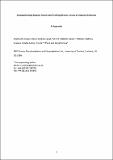Por favor, use este identificador para citar o enlazar a este item:
http://hdl.handle.net/10261/238168COMPARTIR / EXPORTAR:
 SHARE SHARE
 CORE
BASE CORE
BASE
|
|
| Visualizar otros formatos: MARC | Dublin Core | RDF | ORE | MODS | METS | DIDL | DATACITE | |

| Título: | Deubiquitinating enzyme amino acid profiling reveals a class of ubiquitin esterases |
Autor: | De Cesare, Virginia; Carbajo, Daniel CSIC ORCID; Mabbitt, Peter D.; Fletcher, Adam J.; Soetens, Mathieu; Antico, Odetta; Wood, Nicola T.; Virdee, Satpal | Palabras clave: | DUBs Ubiquitin Non-lysine ubiquitination |
Fecha de publicación: | ene-2021 | Editor: | National Academy of Sciences (U.S.) | Citación: | Proceedings of the National Academy of Sciences of the United States of America 118 (4): e2006947118 (2021) | Resumen: | The reversibility of ubiquitination by the action of deubiquitinating enzymes (DUBs) serves as an important regulatory layer within the ubiquitin system. Approximately 100 DUBs are encoded by the human genome, and many have been implicated with pathologies, including neurodegeneration and cancer. Non-lysine ubiquitination is chemically distinct, and its physiological importance is emerging. Here, we couple chemically and chemoenzymatically synthesized ubiquitinated lysine and threonine model substrates to a mass spectrometry-based DUB assay. Using this platform, we profile two-thirds of known catalytically active DUBs for threonine esterase and lysine isopeptidase activity and find that most DUBs demonstrate dual selectivity. However, with two anomalous exceptions, the ovarian tumor domain DUB class demonstrates specific (iso)peptidase activity. Strikingly, we find the Machado–Joseph disease (MJD) class to be unappreciated non-lysine DUBs with highly specific ubiquitin esterase activity rivaling the efficiency of the most active isopeptidases. Esterase activity is dependent on the canonical catalytic triad, but proximal hydrophobic residues appear to be general determinants of non-lysine activity. Our findings also suggest that ubiquitin esters have appreciable cellular stability and that non-lysine ubiquitination is an integral component of the ubiquitin system. Its regulatory sophistication is likely to rival that of canonical ubiquitination. | Versión del editor: | https://doi.org/10.1073/pnas.2006947118 | URI: | http://hdl.handle.net/10261/238168 | DOI: | 10.1073/pnas.2006947118 |
| Aparece en las colecciones: | (IQAC) Artículos |
Ficheros en este ítem:
| Fichero | Descripción | Tamaño | Formato | |
|---|---|---|---|---|
| deCesare_et_al_pnas_combined_revised2.docx | Artículo principal | 9,91 MB | Microsoft Word XML | Visualizar/Abrir |
| pnas.2006947118.sapp.pdf | Material suplementario | 7,61 MB | Adobe PDF |  Visualizar/Abrir |
CORE Recommender
PubMed Central
Citations
30
checked on 19-abr-2024
SCOPUSTM
Citations
38
checked on 23-abr-2024
WEB OF SCIENCETM
Citations
33
checked on 23-feb-2024
Page view(s)
44
checked on 26-abr-2024
Download(s)
69
checked on 26-abr-2024
Google ScholarTM
Check
Altmetric
Altmetric
Artículos relacionados:
NOTA: Los ítems de Digital.CSIC están protegidos por copyright, con todos los derechos reservados, a menos que se indique lo contrario.
